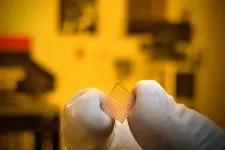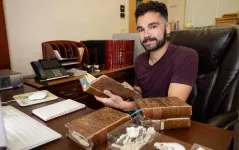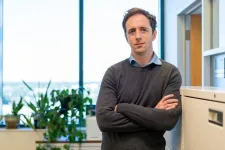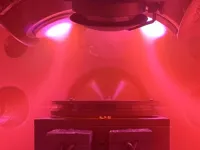(Press-News.org) The melding of visual information (microscopic and X-ray images, CT and MRI scans, for example) with text (exam notes, communications between physicians of varying specialties) is a key component of cancer care. But while artificial intelligence helps doctors review images and home in on disease-associated anomalies like abnormally shaped cells, it’s been difficult to develop computerized models that can incorporate multiple types of data.
Now researchers at Stanford Medicine have developed an AI model able to incorporate visual and language-based information. After training on 50 million medical images of standard pathology slides and more than 1 billion pathology-related texts, the model outperformed standard methods in its ability to predict the prognoses of thousands of people with diverse types of cancer, to identify which people with lung or gastroesophageal cancers are likely to benefit from immunotherapy, and to pinpoint people with melanoma who are most likely to experience a recurrence of their cancer.
The researchers named the model MUSK, for multimodal transformer with unified mask modeling. MUSK represents a marked deviation from the way artificial intelligence is currently used in clinical care settings, and the researchers believe it stands to transform how artificial intelligence can guide patient care.
“MUSK can accurately predict the prognoses of people with many different kinds and stages of cancer,” said Ruijiang Li, MD, an associate professor of radiation oncology. “We designed MUSK because, in clinical practice, physicians never rely on just one type of data to make clinical decisions. We wanted to leverage multiple types of data to gain more insight and get more precise predictions about patient outcomes.”
Li, who is a member of the Stanford Cancer Institute, is the senior author of the study, which was published Jan. 8 in Nature. Postdoctoral scholars Jinxi Xiang, PhD, and Xiyue Wang, PhD, are the lead authors of the research.
Although artificial intelligence tools have been increasingly used in the clinic, they have been primarily for diagnostics (does this microscope image or scan show signs of cancer?) rather than for prognosis (what is this person’s likely clinical outcome, and which therapy is most effective for an individual?).
Part of the challenge is the need to train the models on large amounts of labeled data (this is a microscope slide of a slice of lung tissue with a cancerous tumor, for example) and paired data (here are the clinical notes about the patient from whom the tumor was obtained). But carefully curated and annotated datasets are hard to come by.
Off-the-shelf tool
In artificial intelligence terms, MUSK is what’s called a foundation model. Foundation models pretrained on vast amounts of data can be customized with additional training to perform specific tasks. Because the researchers designed MUSK to use unpaired multimodal data that doesn’t meet the traditional requirements for training artificial intelligence, the pool of data that the computer can use to “learn” during its initial training is expanded by several orders of magnitude. With this head start, any subsequent training is accomplished with much smaller, more specialized sets of data. In effect, MUSK is an off-the-shelf tool that doctors can fine-tune to help answer specific clinical questions.
“The biggest unmet clinical need is for models that physicians can use to guide patient treatment,” Li said. “Does this patient need this drug? Or should we instead focus on another type of therapy? Currently, physicians use information like disease staging and specific genes or proteins to make these decisions, but that’s not always accurate.”
The researchers collected microscopic slides of tissue sections, the associated pathology reports and follow-up data (including how the patients fared) from the national database The Cancer Genome Atlas for people with 16 major types of cancer, including breast, lung, colorectal, pancreas, kidney, bladder, head and neck. They used the information to train MUSK to predict disease-specific survival, or the percentage of people who have not died from a specific disease during a defined time period.
For all cancer types, MUSK accurately predicted the disease-specific survival of a patient 75% of the time. In contrast, standard predictions based on a person’s cancer stage and other clinical risk factors were correct 64% of the time.
In another example, the researchers trained MUSK to use thousands of bits of information to predict which patients with cancers of the lung or of the gastric and esophageal tracts are most likely to benefit from immunotherapy.
“Currently, the major determination about whether to give a patient a particular type of immunotherapy rests on whether that person’s tumor expresses a protein called PD-L1,” Li said. “That’s a biomarker made of just one protein. In contrast, if we can use artificial intelligence to assess hundreds or thousands of bits of many types of data, including tissue imaging, as well as patient demographics, medical history, past treatments and laboratory tests gathered from clinical notes, we can much more accurately determine who might benefit.”
For non-small cell lung cancer, MUSK correctly identified patients who benefited from immunotherapy treatment about 77% of the time. In contrast, the standard method of predicting immunotherapy response based on PD-L1 expression was correct only about 61% of the time.
Similar results were obtained when the researchers trained MUSK to identify which people with melanoma were most likely to relapse within five years after their initial treatment. In this case the model was correct about 83% of the time, which is about 12% more accurate than the predictions generated by other foundation models.
“What’s unique about MUSK is the ability to incorporate unpaired multimodal data into pretraining, which substantially increases the scale of data compared with paired data required by other models,” Li said. “We observed that for all clinical prediction tasks, models that integrate multiple types of data consistently outperform those based on imaging or text data alone. Leveraging these types of unpaired multimodal data with artificial intelligence models like MUSK will be a major advance in the ability of artificial intelligence to aid doctors to improve patient care.”
Researchers from Harvard Medical School contributed to the work.
The study was funded by the National Institutes of Health (grants R01CA222512, R01CA233578, R01CA269599, R01CA285456, R01CA290715 and R01DE030894), and the Stanford Institute for Human-Centered Artificial Intelligence.
END
Unique Stanford Medicine-designed AI predicts cancer prognoses, responses to treatment
AI predicts cancer treatment outcomes
2025-01-08
ELSE PRESS RELEASES FROM THIS DATE:
A new ultrathin conductor for nanoelectronics
2025-01-08
As computer chips continue to get smaller and more complex, the ultrathin metallic wires that carry electrical signals within these chips have become a weak link. Standard metal wires get worse at conducting electricity as they get thinner, ultimately limiting the size, efficiency, and performance of nanoscale electronics.
In a paper published Jan. 3 in Science, Stanford researchers show that niobium phosphide can conduct electricity better than copper in films that are only a few atoms thick. Moreover, these films can be created and deposited at sufficiently low temperatures to be compatible with modern computer ...
Synthetic chemicals and chemical products require a new regulatory and legal approach to safeguard children’s health
2025-01-08
Chestnut Hill, Mass (01/08/2025) – Nations must start testing and regulating chemicals and chemical products as closely as the current systems that safeguard prescription drugs or risk rising rates of chronic illnesses among children, according to a New England Journal of Medicine report by a group of experts writing as the Consortium for Children’s Environmental Health.
Global chemical inventories contain an estimated 350,000 products – such as manufactured chemicals, chemical ...
The genes that grow a healthy brain could fuel adult glioblastoma
2025-01-08
FOR IMMEDIATE RELEASE
Media Contact: Levi.Gadye@ucsf.edu, (415) 502-6397
Subscribe to UCSF News
The discovery of a new type of stem cell in the brain could usher in better treatments for the deadliest brain tumor.
UCSF scientists have discovered a stem cell in the young brain that’s capable of forming the cells found in tumors. The breakthrough could explain how adult brain cells take advantage of developmental processes to instigate the explosive growth seen in deadly brain cancers like glioblastoma.
They made the discovery while taking a broad genomic survey of human brain ...
New MSU study explains the delayed rise of plants, animals on land
2025-01-08
EAST LANSING, Mich. – If you like the smell of spring roses, the sounds of summer birdsong and the colors of fall foliage, you have the stabilization of the ozone layer to thank for it. Located in the stratosphere where it shields the Earth from harmful ultraviolet radiation, the ozone layer plays a key role in preserving the planet’s biodiversity.
Now, we may have a better idea of why that took more than 2 billion years to happen.
Michigan State University researcher Dalton Hardisty contributed to a new Yale University-led study finding that Earth’s early atmosphere hosted a battle royal between ...
UTA becomes one of largest natural history libraries
2025-01-08
Thanks to in-kind donations of tens of thousands of rare books, scientific journals, and articles, and reports over the past two years, The University of Texas at Arlington’s Amphibian and Reptile Diversity Research Center (ARDRC) has become one of the largest publicly accessible herpetology libraries in the world.
“Thanks to 12 independent donors, including the Joseph Rex Dinardo Jr. Herpetology and Natural History Science Research Trust in Philadelphia, Dr. Jonathan Campbell, William Lamar, Drs. Jay and Rebecca Savage, and Louis Porras, we now have thousands ...
Number of autistic individuals enrolled in Medicaid and receiving federal housing support increased by 70% from 2008-16
2025-01-08
Affordable and stable housing is critical to improving health across a person's lifespan. People with disabilities, including autism, comprise a significant share of people in need of housing assistance. However, the intersection of housing and health among individuals with autism is largely unknown because data on public housing and public health are not connected. Researchers from Drexel University’s A.J. Drexel Autism Institute examined how many autistic people in the United States received housing ...
St. Jude scientists create scalable solution for analyzing single-cell data
2025-01-08
Researchers have amassed vast single-cell gene expression databases to understand how the smallest details impact human biology. However, current analysis methods struggle with the large volume of data and, as a result, produce biased and contradictory findings. Scientists at St. Jude Children’s Research Hospital created a machine-learning algorithm capable of scaling with these single-cell data repositories to deliver more accurate results. The new method was published today in Cell Genomics.
Before single-cell analysis, bulk gene expression data ...
What is the average wait time to see a neurologist?
2025-01-08
MINNEAPOLIS – Older people wait an average of just over a month to see a neurologist for specialty care after being referred by their primary care physician or another physician, according to a study published in the January 8, 2025, online issue of Neurology®, the medical journal of the American Academy of Neurology. The study, which looked at people who have Medicare insurance, also found some people wait more than three months to see a neurologist.
“Neurologists provide important and ongoing care for people ...
Proximity effect: Method allows advanced materials to gain new property
2025-01-08
UNIVERSITY PARK, Pa. — Ferroelectrics are special materials with polarized positive and negative charges — like a magnet has north and south poles — that can be reversed when external electricity is applied. The materials will remain in these reversed states until more power is applied, making them useful for data storage and wireless communication applications.
Now, turning a non-ferroelectric material into one may be possible simply by stacking it with another ferroelectric material, according to a team led by scientists from Penn State who demonstrated the phenomenon, called proximity ferroelectricity.
The ...
LJI researchers shed light on devastating blood diseases
2025-01-08
LA JOLLA, CA—Scientists at La Jolla Institute for Immunology (LJI) have discovered how a mutated gene kicks off a dangerous chain of events during blood cell production.
The study, published recently in the Proceedings of the National Academy of Sciences, reveals how a mutated gene called ASXL1 is involved in a disease called clonal hematopoiesis, a precursor to malignant diseases such as myeloid malignancies and chronic monomyelocytic leukemia.
"We know that many diseases—and all cancers—are driven by mutations in the genome," says LJI Instructor Zhen Dong, ...
LAST 30 PRESS RELEASES:
Why are there so many Nordic mediators?
Young shark species more vulnerable to extinction
Mobile fetal heart monitoring linked to fewer newborn deaths in Tanzania
Bluey’s dad offered professorial chair in archaeology at Griffith University
Beyond small data limitations: Transfer learning-enabled framework for predicting mechanical properties of aluminum matrix composites
Unveiling non-thermal catalytic origin of direct current-promoted catalysis for energy-efficient transformation of greenhouse gases to valuable chemicals
Chronic breathlessness emerging as a hidden strain on hospitals
Paleontologists find first fossil bee nests made inside fossil bones
These fossils were the perfect home for ancient baby bees
Not everyone reads the room the same. A new study examines why.
New research identifies linked energy, immune and vascular changes in ME/CFS
Concurrent frailty + depression likely boost dementia risk in older people
Living in substandard housing linked to kids’ missed schooling and poor grades
Little awareness of medical + psychological complexities of steroid cream withdrawal
Eight in 10 trusts caring for emergency department patients in corridors, finds BMJ investigation
NASA’s Webb telescope finds bizarre atmosphere on a lemon-shaped exoplanet
The gut bacteria that put the brakes on weight gain in mice
Exploring how patients feel about AI transcription
Category ‘6’ tropical cyclone hot spots are growing
Video: Drivers struggle to multitask when using dashboard touch screens, study finds
SLU research shows surge in alcohol-related liver disease driving ‘deaths of despair’
Rising heat reshapes how microbes break down microplastics, new review finds
Roots reveal a hidden carbon pathway in maize plants
Membrane magic: FAMU-FSU researchers repurpose fuel cells membranes for new applications
UN Member States pledge to increase access to diagnosis and inhaled medicines for the 480 million people living with COPD
Combination therapy shows potential to treat pediatric brain cancer ATRT
Study links seabird nesting to shark turf wars in Hawai‘i
Legal sports betting linked to sharp increases in violent crime, study finds
Breakthrough AI from NYUAD speeds up discovery of life-supporting microbes
New Eva Mayr-Stihl Foundation funding initiative boosts research at University of Freiburg on adaptation of forests to global change
[Press-News.org] Unique Stanford Medicine-designed AI predicts cancer prognoses, responses to treatmentAI predicts cancer treatment outcomes



